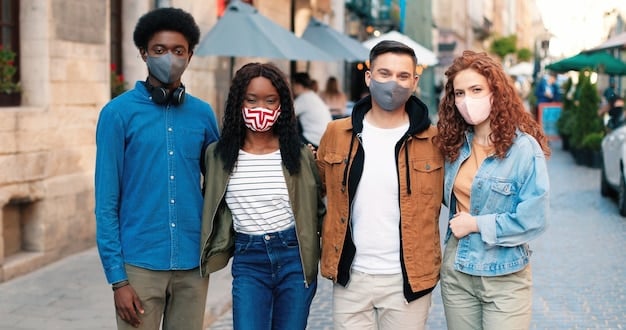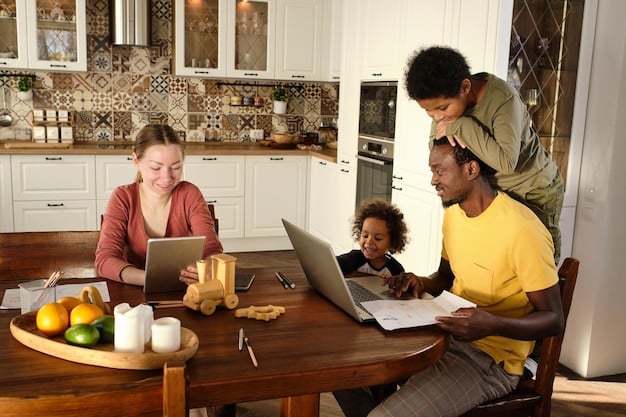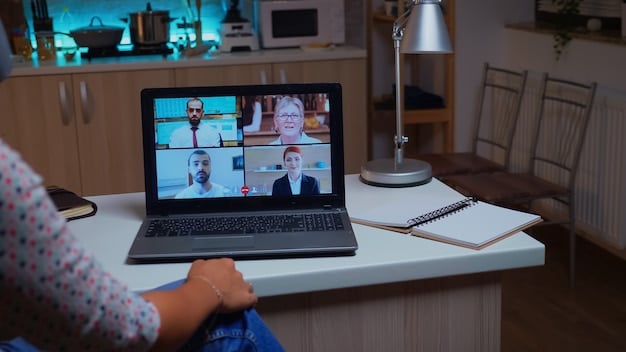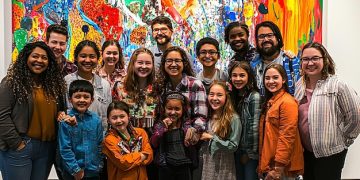How the Pandemic Reshaped American Values & Priorities

Anúncios
The pandemic has significantly altered American cultural values and priorities, leading to increased concerns about health, a greater emphasis on family and community, and a reevaluation of work-life balance.
The COVID-19 pandemic has been a transformative event, impacting not only public health but also deeply influencing the cultural values and priorities of Americans. The ripple effects of this global crisis continue to reshape society in profound ways. How Has the Pandemic Changed American Cultural Values and Priorities? Let’s explore how.
Anúncios
The Initial Shock and Shift in Priorities
The onset of the pandemic brought about immediate and dramatic changes to daily life. Lockdowns, social distancing, and the constant threat of infection forced individuals and communities to reassess what truly mattered.
Initially, survival instincts kicked in. Basic needs like food, shelter, and health security took precedence over everything else. This period of intense uncertainty revealed certain fault lines in American society while also highlighting the importance of collective action and mutual support.
Anúncios

The Primacy of Health and Safety
One of the most significant shifts has been an increased awareness of health and safety. The pandemic made people acutely aware of their own mortality, leading to behavioral changes aimed at reducing risk.
- Emphasis on hygiene: Regular hand washing, sanitizing surfaces, and wearing masks became commonplace practices.
- Focus on preventative care: Many Americans started prioritizing regular check-ups and vaccinations.
- Mental health awareness: The pandemic highlighted the importance of mental well-being, leading to increased demand for mental health services.
The pandemic underscored the fragility of life and the importance of protecting oneself and loved ones. This heightened sensitivity to health is likely to persist for years to come.
Strengthening of Family and Community Bonds
Social distancing measures, while necessary, also led to increased isolation and loneliness. This prompted many Americans to place greater emphasis on strengthening ties with family and close friends.
Families spent more time together at home, engaging in activities like cooking, playing games, and watching movies. Communities organized mutual aid initiatives to support vulnerable members, demonstrating a renewed sense of collective responsibility.
The Rise of Virtual Connections
Technology played a crucial role in maintaining social connections during the pandemic. Video conferencing, social media, and online communities allowed people to stay in touch despite physical distance.
- Virtual family gatherings: Families used video calls to celebrate holidays and birthdays.
- Online support groups: People with shared interests or experiences connected through online forums and groups.
- Local community networks: Neighbors used social media to offer assistance and share information.

This reliance on technology accelerated the adoption of digital tools for social interaction, transforming how people connect and communicate.
Reevaluating Work-Life Balance
The pandemic forced many businesses to adopt remote work policies, leading to a reevaluation of traditional work structures. Employees experienced both the benefits and challenges of working from home, prompting reflection on the importance of work-life balance.
Many workers discovered they could be just as productive, if not more so, while working remotely. This newfound flexibility allowed them to spend more time with family, pursue personal interests, and reduce stress associated with commuting.
The Great Resignation and Shifting Priorities
The pandemic also contributed to the “Great Resignation,” a phenomenon characterized by a large number of workers voluntarily leaving their jobs. This was driven by a combination of factors, including burnout, dissatisfaction with work conditions, and a desire for more meaningful employment.
Workers began prioritizing their well-being and seeking out jobs that offered better pay, benefits, and work-life balance. This shift in priorities has put pressure on employers to create more attractive and supportive work environments.
In summary, the pandemic has made many Americans rethink their relationship with work, leading to a greater emphasis on flexibility, purpose, and overall well-being.
Increased Awareness of Social Inequities
The pandemic exposed and exacerbated existing social and economic inequalities in the United States. Vulnerable populations, including low-income communities, racial and ethnic minorities, and essential workers, were disproportionately affected by the virus.
These disparities highlighted the need for systemic changes to address issues such as access to healthcare, affordable housing, and economic opportunity. A lot of people started to question structures.
Moving forward, addressing these inequalities will require a concerted effort from policymakers, community organizations, and individuals.
Political Polarization and Eroding Trust
The pandemic also deepened political divisions and eroded trust in institutions. Disagreements over mask mandates, vaccine policies, and government responses to the crisis fueled partisan animosity.
The spread of misinformation and conspiracy theories online further exacerbated these divisions. Combating misinformation and strengthening trust in reliable sources of information are essential for promoting social cohesion and effective governance.
- Combating Misinformation: Fact-checking initiatives and media literacy programs are crucial for countering the spread of false information.
- Strengthening Institutions: Reforms are needed to ensure that government agencies are transparent, accountable, and responsive to the needs of the public.
- Promoting Dialogue: Creating spaces for constructive dialogue and respectful debate can help bridge divides and foster understanding across different political viewpoints.
The need to find common ground and rebuild trust in institutions has become more pressing than ever.
Embracing Simplicity and Sustainability
The pandemic prompted many Americans to reevaluate their consumption patterns and embrace more sustainable lifestyles. With travel restrictions and economic uncertainty, people started focusing on local resources and simpler forms of entertainment.
Gardening, cooking at home, and spending time in nature became popular activities. There was increased interest in supporting local businesses and reducing waste.
- Home Gardening: Growing fruits, vegetables, and herbs at home became a popular way to connect with nature and ensure access to fresh produce.
- Sustainable Consumption: Many Americans started prioritizing eco-friendly products and reducing their carbon footprint.
- Local Tourism: Exploring nearby attractions and supporting local businesses gained popularity as international travel became more challenging.
There is an increase in emphasis on simplicity, sustainability and reconnecting with nature. These are great things during a global crisis, or any time really.
| Key Point | Brief Description |
|---|---|
| ❤️ Family Bonds | Families spent more time together, strengthening relationships. |
| 💪 Health Focus | Increased awareness and prioritization of physical and mental health. |
| ⚖️ Work-Life Balance | Reevaluating work and the importance of personal time and flexibility. |
Frequently Asked Questions
▼
The pandemic has prompted many Americans to reevaluate their relationship with work, leading to a greater emphasis on flexibility, purpose, and overall well-being. Remote work has shown that productivity can be maintained outside of traditional office settings.
▼
Families have spent more time together, which has strengthened bonds but also presented challenges. Balancing work, childcare, and education at home has been difficult, but it has also highlighted the importance of family support.
▼
The pandemic has had a significant impact on mental health, with increased rates of anxiety, depression, and substance abuse. Isolation, economic uncertainty, and fear of infection have all contributed to these challenges.
▼
Yes, the pandemic has heightened awareness of healthcare disparities and the importance of accessible, affordable care. Many Americans now place a greater emphasis on preventative care and are more likely to seek medical attention when needed.
▼
The pandemic has deepened political divisions, with disagreements over mask mandates, vaccine policies, and government responses fueling partisan animosity. Combating misinformation and rebuilding trust in institutions are essential.
Conclusion
In conclusion, the COVID-19 pandemic has brought about profound shifts in American cultural values and priorities. The increased focus on health, family, work-life balance, and social equity are likely to have lasting effects on society. While the challenges have been significant, the pandemic has also revealed the resilience and adaptability of the American people.





